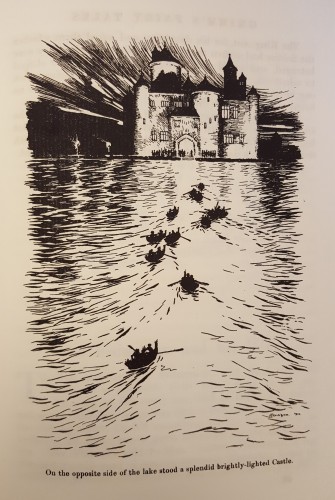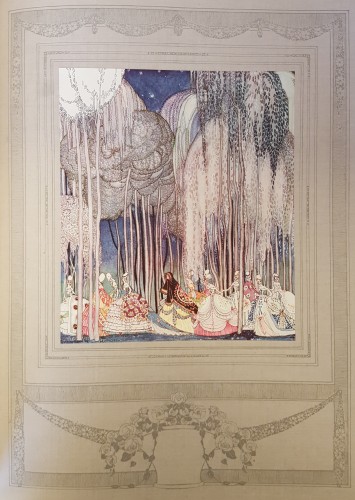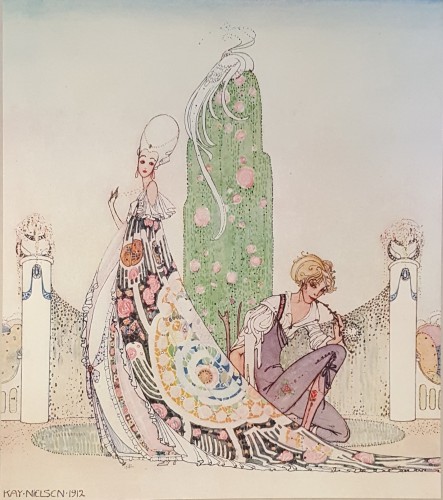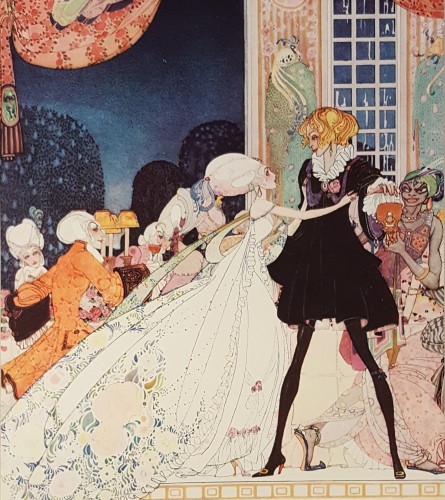Shoes - and dancing shoes in particular - return again and again as a central motif of fairy tales - from the “just right” glass slipper that declares Cinderella to be the Prince’s ballroom crush to the red hot iron slippers in which Snow White’s evil stepmother is forced to dance till she dies. However, perhaps no fairy tale contains quite so many shoes as “The Twelve Dancing Princesses.” Included in German Popular Stories: Translated from the Kinder und Haus-Märchen, an early English translation of Jacob and Wilhelm Grimm’s fairy tales. “The Twelve Dancing Princesses tells of twelve royal sisters who are locked into their bedroom each night, and yet emerge in the morning with their shoes worn out by dancing. Night afger night, week after week, 12 pairs of shoes ruined. Where do they go? No one knows, and the princesses won't share their secret.

"The Twelve Dancing Princesses," The Fairy Tales of the Brothers Grimm (London: Freemantle & Co., 1909). The Chalat Family Arthur Rackham Collection, copy no. 367.
In despair, their kingly father offers the kingdom and a princess-of-choice to anyone able to solve the mystery in three nights. As added incentive, failure is to be met with execution. After numerous princes have failed, a soldier returning from the wars toys with trying his luck, and is encouraged by an elderly woman whom he meets on the road. Armed with a cloak of invisibility and the old woman’s warning not to drink the nightly wine, he stealthily follows the princesses to a underground wonderland of silver, gold, and diamond forests, where the princesses dance all night in a brightly-lit castle with mysterious princes.
Although the youngest princess fears they are being followed, no one else suspects a thing, even when the soldier breaks off twigs and steals a goblet. On the third morning, the soldier presents these tokens to the king. Confronted with this proof, the princesses confess all, whereupon the soldier claims the eldest daughter as his bride and becomes heir to the kingdom.
“The Twelve Dancing Princesses” leaves numerous questions unanswered: How did the princesses discover the underground castle? Did they go there every night by choice orwere they under some kind of unspeficied spell? Why did discovery break such a spell, if it exists? And who were the handsome princes they danced with every night?
Various re-tellings of the story respond to these and other points of ambiguity. In the version recounted by Sir Arthur Quiller-Couch in In Powder and Crinoline, Fairy Tales Retold (1913), which is very similar to the French version Andrew Lang included in The Red Fairy Book (1890), the soldier is replaced by a poor peasant boy named Michael, who gains entry to the castle by taking a post as a gardener and provides the princesses with bouquets each morning. In this version, Michael is assisted by two magical laurel trees given to him in a dream by a lady in a golden dress. He also engages in a certain amount of courtship with the youngest princess, named Lina and reveals his discovery to her (and by extension to her sisters).

"The Twelve Dancing Princesses," Sir Arthur Quiller-Couch, In Powder and Crinoline: Old Fairy Tales ([London]: Hodder & Stoughton, 1913). Gift of Joann and Ned I. Chalat, copy no. 1.
Ultimately, Michael decides that rather than give up Lina’s secret to the king, he will - like the other failed princes - accept the drink that will trap him in the underground palace at the end of the night. However, at the last moment, Lina declares that she would rather marry a gardener than have him drink the cup. Each of her sisters chooses one of the other princes to be her husband and the castle collapses behind them as everyone escapes to the surface, where Michael and Lina are happily married (although Lina burns the laurel trees as they “gave him too much advantage over his wife.”) In this version, the princes who tried and failed to discover the princesses’ whereabouts are the same as the dancing princes underground, which resolves one mystery, but introduces another. Who were the princesses dancing with before their father started offering rewards for their whereabouts?
Working with the German and French versions (respectively), Arthur Rackham and Kay Nielsen - two of the greatest illustrators of the early 20th century - offer quite distinct approaches to “The Twelve Dancing Princesses.” Rackham (1867-1939) is best known for his gift of portraying other-worldly landscapes anchored in a sense of physicality and detail. He began illustrating books in 1894 and the 1900 edition of The Fairy Tales of the Brothers Grimm further bolstered his popular and critical appeal. It was re-issued in 1909 in a deluxe edition of 750 copies bound in vellum with yellow silk ties. In the Grimms’ rendition, “The Twelve Dancing Princesses” is quite a short story - not very much longer than the summary above - and it is perhaps for this reason that it does not receive the honor of a full-color plate, but merely the title vignette of dancing shoes (at the top of this post) and a black and white line drawing showing the princes and princesses rowing across the underground lake to the enchanted castle. Even in these, however, one can see the flowing lines and lyrical allure of Rackham’s style.
Illustrating the same story more than a decade later, Nielsen (1886-1957) was just embarking on his career in 1913 when he accepted a commission to illustrate Sir Arthur Quiller Couch’s In Powder and Crinoline, Fairy Tales. Although Rackham is often mentioned as an influence on Nielsen’s style, and both artists worked in watercolor over pen & ink, there are marked differences in their style. Even when working in color, Rackham tends towards a soft, neutral palate with delicate details. Nielsen, on the other hand, embraces brighter colors, bolder lines, and more stylized figures - all traits that may in part be traced to the inspiration he drew from Persian miniatures and Japanese woodblocks, with the latter especially influencing his use of asymetry and open space in his composition. These characteristics are particularly clear in his illustrations of Princess Lina passing Michael in the garden, and Lina’s declaration of love that prevents Michael from drinking the fatal cup in the underground palace.

"The Twelve Dancing Princesses," Sir Arthur Quiller-Couch, In Powder and Crinoline: Old Fairy Tales ([London]: Hodder & Stoughton, 1913). Gift of Joann and Ned I. Chalat, copy no. 1.

"The Twelve Dancing Princesses," Sir Arthur Quiller-Couch, In Powder and Crinoline: Old Fairy Tales ([London]: Hodder & Stoughton, 1913). Gift of Joann and Ned I. Chalat, copy no. 1.